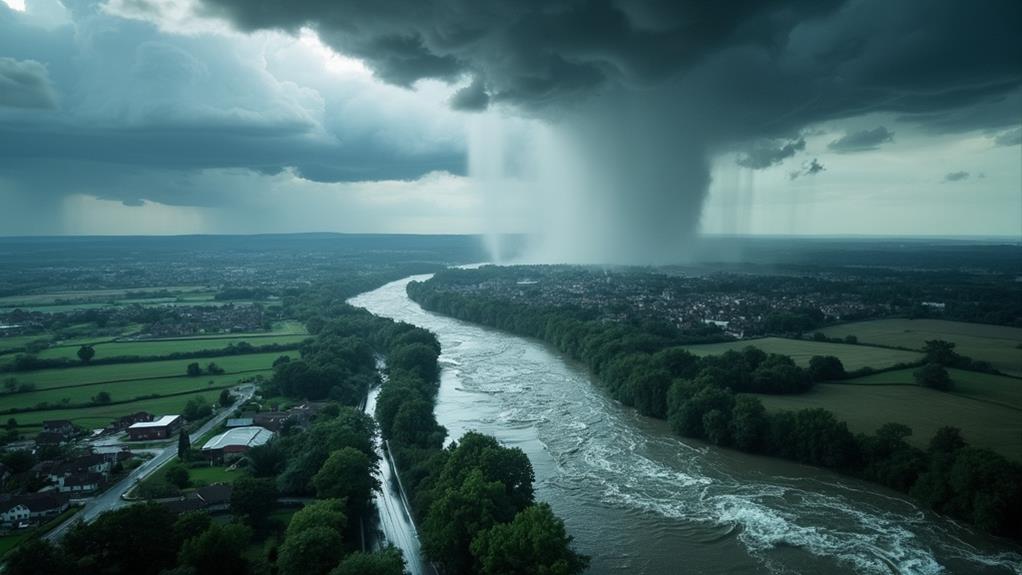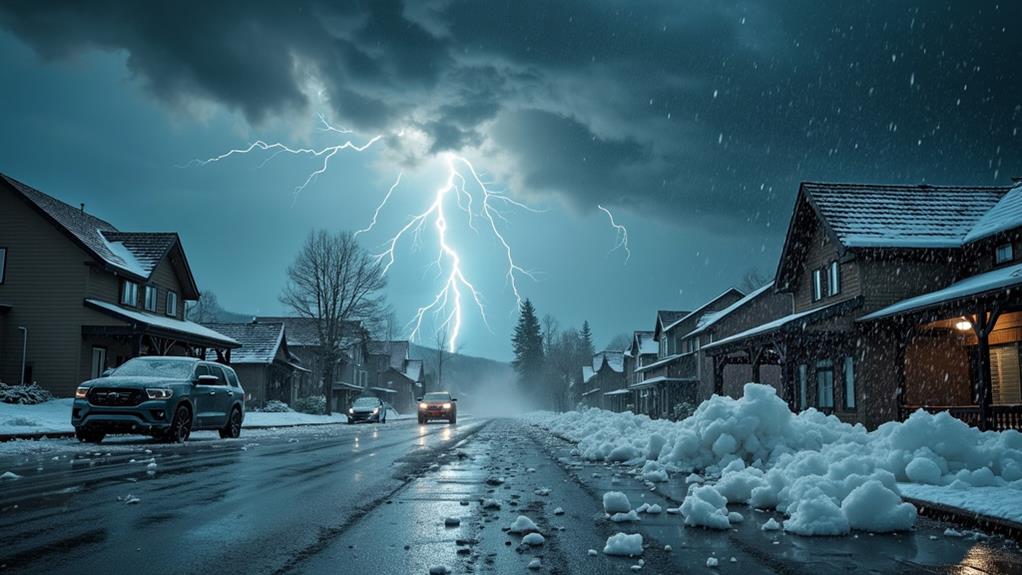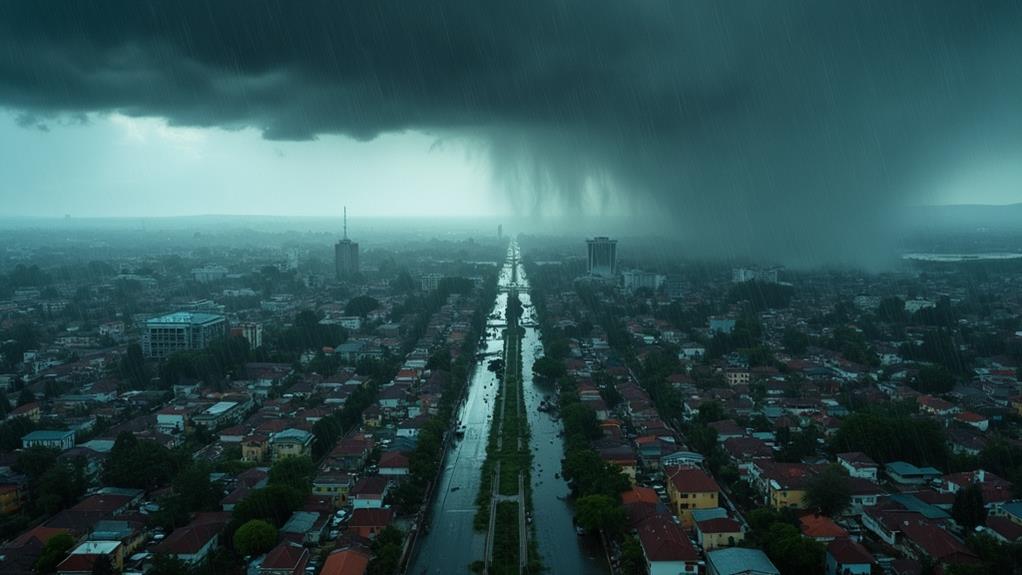Notable Flash Floods in US History Guide
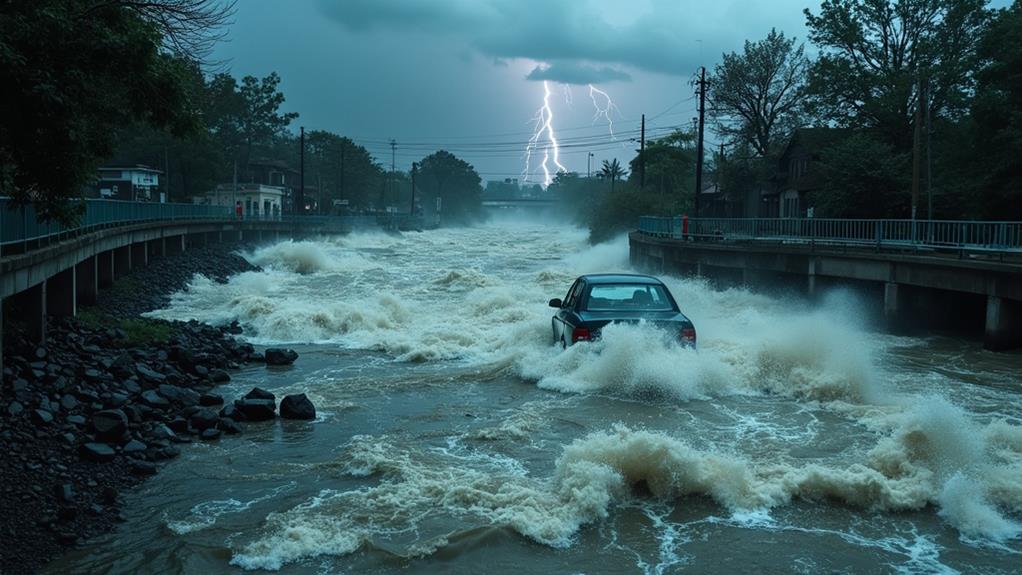
When it involves the most notable flash floods in U.S. history, you've got several catastrophic events to evaluate. The St. Francis Dam Failure in 1928 released 12 billion gallons of water, causing 431 deaths and changing California's dam safety laws. The 1903 Heppner Flash Flood killed 247 people, emphasizing the need for better flood management. The 1976 Big Thompson Canyon Flood saw 12 inches of rain in four hours, leaving 144 dead. There's also the 1972 Rapid City Flood, the Kansas City Flash Flood of 1977, and the Central Texas and Fort Collins floods from the '90s. Keep going to uncover more about each of these tragic events and their impacts.
Key Takeaways
- The St. Francis Dam Failure in 1928 caused one of California's deadliest disasters with at least 431 fatalities.
- The Heppner Flash Flood in 1903 highlighted the need for improved flood management with 247 deaths and significant property damage.
- The Big Thompson Canyon Flood in 1976 resulted in 144 fatalities and $35 million in property damage due to intense rainfall.
- The Rapid City Flood in 1972, caused by a dam failure, resulted in 238 deaths and $164 million in damages.
- The Central Texas Flood in 1991 saw 17 inches of rain in 24 hours, causing over $100 million in damage and at least 15 fatalities.
The St. Francis Dam Failure
The St. Francis Dam failure stands as a grim chapter in California history. On March 12, 1928, the dam, designed by engineer William Mulholland, released a catastrophic surge of approximately 12 billion gallons of water. The floodwaters raced down the San Francisquito Canyon at over 30 miles per hour, leaving devastation in their wake. This disaster resulted in at least 431 fatalities, making it one of the deadliest in the state's history.
The failure was primarily due to engineering flaws and inadequate geological assessments. Mulholland and his team did not fully account for the geological conditions underlying the dam, leading to its eventual collapse. The event highlighted the critical importance of thorough geological assessments and strict engineering standards in dam safety.
The St. Francis Dam disaster had far-reaching implications, prompting significant changes in dam safety regulations and oversight. It underscored the need for careful planning and caution in engineering projects, especially those with the potential to impact thousands of lives. The lessons learned from this tragic event continue to inform and shape modern engineering practices and regulatory frameworks, ensuring that such a disaster is never repeated.
The Heppner Flash Flood
While the St. Francis Dam Failure is infamous, you can't overlook the Heppner Flash Flood of June 14, 1903. This disaster struck Heppner, Oregon, when an intense storm released over 8 inches of rain in just hours. The deluge overwhelmed local waterways, causing floodwaters to surge up to 20 feet high. This wall of water devastated the town, making it one of the deadliest flash floods in U.S. history.
You'd be shocked to know the flood resulted in 247 fatalities and extensive property damage. Approximately 200 homes and businesses were obliterated, with the total damage pegged at $19.5 million at the time. The sheer force of the floodwaters left the community in ruins, underscoring the need for improved flood management.
The Heppner Flash Flood didn't just leave a physical scar; it reshaped flood management practices across the country. Before this event, many towns were ill-prepared for such natural calamities. The tragic outcome in Heppner highlighted the importance of advanced planning and infrastructure to manage flood risks effectively. It serves as a sobering reminder of nature's power and the necessity for vigilance in flood management.
Big Thompson Canyon Flood
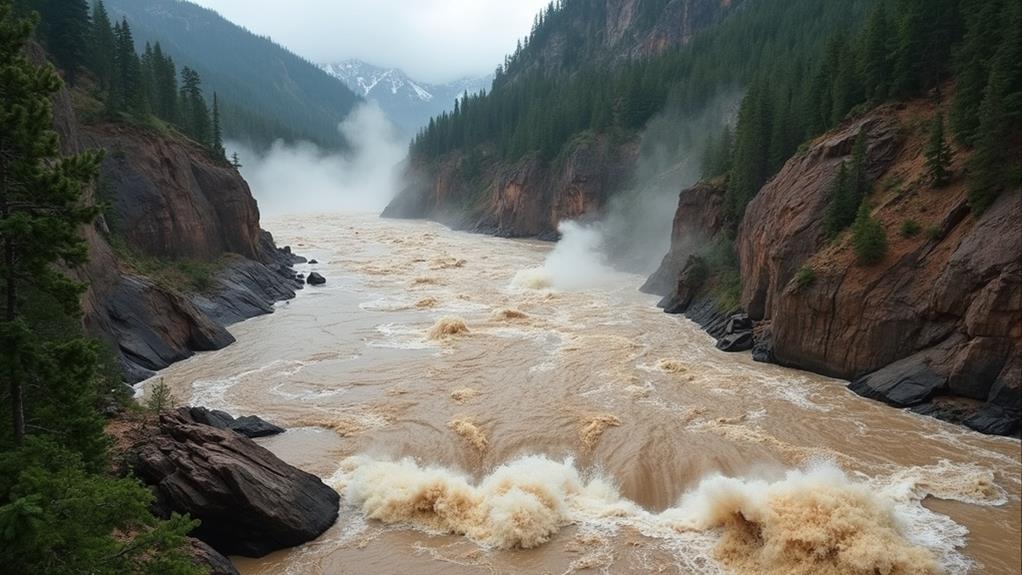
On July 31, 1976, an unprecedented deluge struck Big Thompson Canyon, Colorado, when 12 inches of rain fell in just four hours, triggering a catastrophic flash flood. This sudden and brutal surge of water reached speeds of over 30 miles per hour, creating a deadly wall of debris and water that devastated the area. The flash flood resulted in the tragic deaths of 144 people, making it one of the deadliest in U.S. history.
The powerful floodwaters swept away approximately 400 homes and numerous vehicles, leaving a path of destruction in their wake. Damages were estimated at around $35 million, a staggering amount for the era. The sheer volume of water and the rugged terrain made rescue and recovery efforts extremely challenging. Local and state agencies mounted a massive response, but the swift and relentless nature of the flood complicated their efforts.
As you think about the Big Thompson Canyon Flood, you can't help but feel the profound impact it had on Colorado and its residents. The community was devastated, and the event serves as a stark reminder of the destructive power of nature and the importance of preparedness in the face of such disasters.
Rapid City Flood
Amidst the tranquility of a typical June day in 1972, Rapid City, South Dakota, was suddenly thrust into chaos. On June 9, intense rainfall battered the region, leading to a staggering 12 inches of rain in a short time. This deluge caused the Canyon Lake Dam to fail, triggering the Rapid City Flood.
You can imagine the sheer terror as water levels surged rapidly. In mere minutes, the city was overwhelmed, resulting in one of the deadliest flash floods in U.S. history. Sadly, 238 lives were lost, and the community was left grappling with the devastating aftermath.
The flood wreaked havoc on Rapid City, destroying over 3,000 homes and 200 businesses. Damages were estimated at around $164 million, a staggering amount for the time. The disaster underscored the critical need for improved flood management and emergency response strategies.
In response, significant changes were implemented to better prepare for such events in the future. The Rapid City Flood serves as a grim reminder of nature's power and the importance of vigilance and preparedness in the face of potential flash flooding.
Kansas City Flash Flood
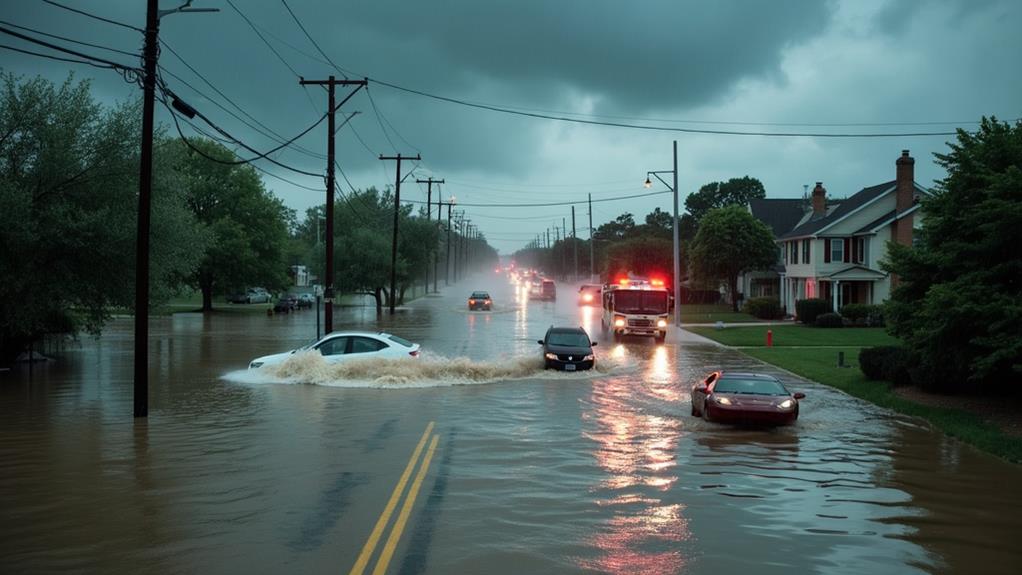
Just five years after the Rapid City Flood, another devastating flash flood struck, this time in Kansas City, Missouri. On July 13-14, 1977, a severe thunderstorm released over 12 inches of rain in a short period. This torrential downpour led to an overwhelming flash flood that wreaked havoc on the city. The floodwaters quickly inundated urban areas, resulting in significant property loss.
Estimates of the damage reached over $100 million, with thousands of homes and vehicles destroyed. Tragically, 17 lives were lost, primarily due to drowning in vehicles caught in the rising floodwaters. The local drainage systems were simply no match for the sheer volume of water, causing several creeks and rivers to fail and overflow.
In the aftermath, Kansas City took decisive steps to prevent such a disaster from happening again. Improved flood control measures were implemented, including the expansion of drainage systems and increased public awareness campaigns focused on flood preparedness. These measures aimed to better protect the urban areas from future flash floods and reduce the risk of property loss and loss of life. The Kansas City flash flood remains a grim reminder of the destructive power of severe weather.
Central Texas Flood
Experiencing relentless rainfall, Central Texas faced a catastrophic flash flood in December 1991. With an astonishing 17 inches of rain falling within just 24 hours, the region was quickly overwhelmed by severe flooding. The flash floods wreaked havoc, causing at least 15 fatalities and over $100 million in damages, making it one of the costliest events in Texas history.
Major cities like Austin and San Antonio were hit hard. Homes and businesses were inundated, forcing widespread evacuations. The heavy rains caused rivers and creeks to overflow, leading to significant damage to infrastructure. Roads and bridges were particularly affected, creating further chaos and complicating rescue efforts.
In the wake of the disaster, local and state authorities quickly realized the need for better flood management and emergency response. They implemented improvements designed to prepare for future flash floods, aiming to minimize the risk of fatalities and reduce damages. These strategies included enhancing early warning systems, improving drainage infrastructure, and conducting public awareness campaigns.
Fort Collins Flood
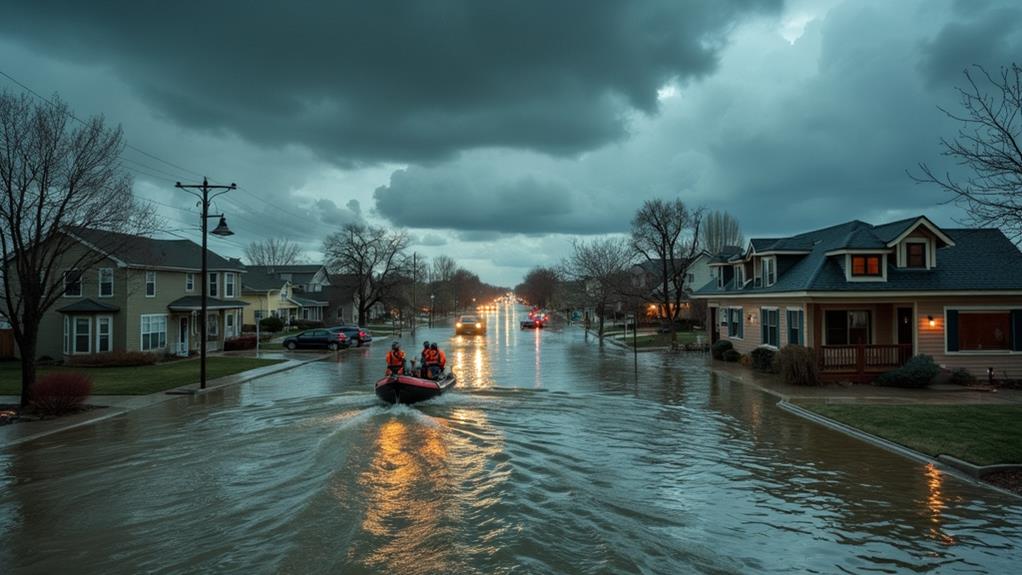
After Central Texas faced its devastating flood, another significant event unfolded in Fort Collins, Colorado. On July 28-29, 1997, a slow-moving thunderstorm released nearly 12 inches of rain in just a few hours, causing catastrophic flash flooding. The Fort Collins Flood tragically resulted in the deaths of 5 people and caused around $200 million in damages, making it one of Colorado's most significant flooding events.
The Cache la Poudre River rose rapidly, its water levels reaching 11 feet above flood stage. This surge devastated downtown Fort Collins and surrounding areas. Approximately 1,000 homes were damaged or destroyed, displacing many residents and triggering long-term recovery efforts.
In response to the disaster, Fort Collins took significant steps to improve flood management and emergency response protocols. Better warning systems were developed, and infrastructure upgrades were made to mitigate future risks. These measures aimed to protect residents and reduce the impact of potential flash flooding events.
The Fort Collins Flood serves as a stark reminder of the destructive power of nature and the importance of preparedness. By learning from past events, communities can better protect themselves and build resilience against future disasters.
Frequently Asked Questions
What Was the Worst Flash Flood in US History?
The worst flash flood in U.S. history happened on May 31, 1889, in Johnstown, Pennsylvania. Deadly storms caused the South Fork Dam to fail, releasing a massive wall of water. This urban runoff disaster led to over 2,200 deaths and significant historical impacts. Climate change and poor water management highlighted the need for better flood preparedness. Today, emergency response, flood insurance, and community resilience are essential for disaster recovery.
What Was the Greatest Flood in US History?
You're wondering about the greatest flood in U.S. history. The Johnstown Flood of 1889 stands out due to its catastrophic impact. It highlighted major infrastructure challenges, emphasized the need for better water management, and pushed for improved flood prevention. This disaster shaped emergency response strategies, underscored the importance of flood insurance, and encouraged community resilience. Today, climate change makes such events a stark reminder of the necessity for robust disaster recovery plans.
What Are the 10 Worst Floods in History?
When considering the 10 worst floods in history, you'd look at catastrophic river events, urban flooding, and the historical impact of each disaster. Climate change plays a role in increasing flood risks. Effective emergency response, flood insurance, and community resilience are essential. Floodplain management and flood prevention measures can mitigate damage. Disaster recovery is significant for affected regions. These factors shape how we remember and learn from these devastating events.
What Is the Biggest Flash Flood in History?
The biggest flash flood in history is the Johnstown Flood of 1889. You need to understand historic events like this to advance emergency response and flood preparedness. Flooding causes, including dam failures and climate change, can devastate river systems and urban areas. Public awareness and flood insurance are essential for disaster recovery. Learning from past events, we can improve our infrastructure to better handle future floods.

